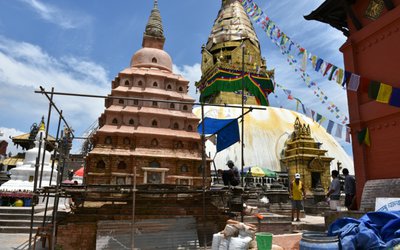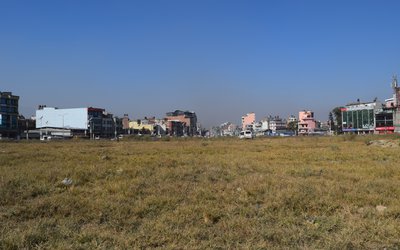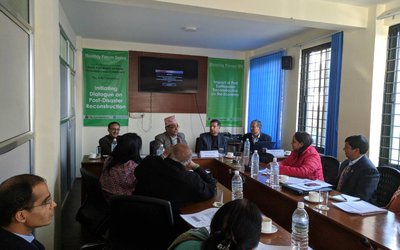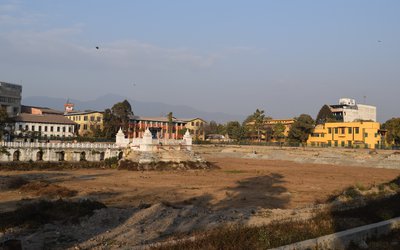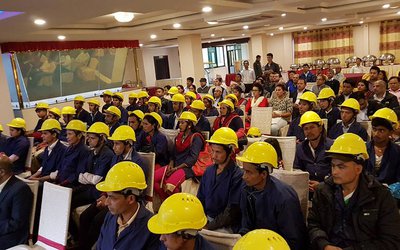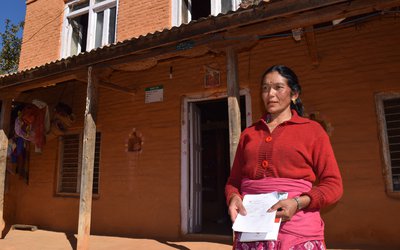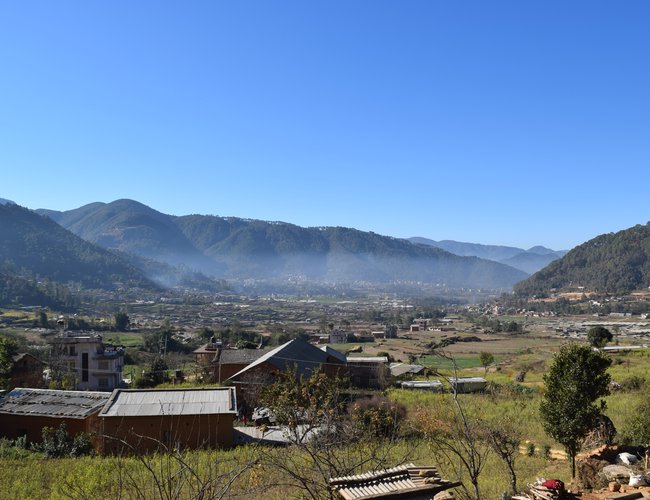
“I have already knocked the doors of local politicians and elected ward chairs and visited all the offices involved in the private housing grant, including NRA’s District Unit. Everyone expresses serious concern and gives assurances about including my name in the list of beneficiaries. But my name is yet to be included officially,” said forty-five-year old Manju Bharati, a resident of Godavari Municipality, Ward No 2, Dhobikhola. “I don’t know how many places I will have to visit and how long I will have to do the waiting, “said Bharati, a single woman, who was left out in the beneficiaries list prepared by the Central Bureau of Statistics.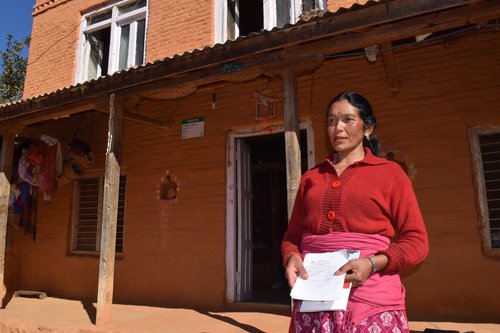
“Look, this is my house, the shelter I have been living in,” Bharati said, pointing to her cracked home, which is half demolished. “I have got a red card attesting the damage by the earthquake and all of my neighbors have testified. Is not it enough to prove my eligibility to be on the list? I don’t know what else they need.”
Although three teams of technicians from the National Reconstruction Authority have already visited her home, collected data and taken her neighbors’ eyewitness accounts, nothing has changed.
“I visited NRA office last week and met engineers and the head of the unit. They assured me of considering my case. But I doubt if that happens in time,” said Bharati.
Rule over Rules
Nepal’s earthquake reconstruction is too bureaucratic and complex as it is guided by one act, one regulation and several other guidelines and working procedures.
Victims have to fulfill all the criteria included in the Act Relating to Reconstruction of the Earthquake Affected Structures 2015.
The beneficiaries have to pass through NRA’s Post Disaster Recovery Framework, Procedure for the Reconstruction for Grant Distribution for the Private House Damage by the earthquake 2016 (Revised 2017), Reconstruction of Structure Damaged by Earthquake Rule 2016, the Procedure Relating to Grievances Management with Regard to Reconstruction and Restitution 2016, Technical Supervision of the Reconstruction of private houses 2016. These govern the private housing reconstruction process.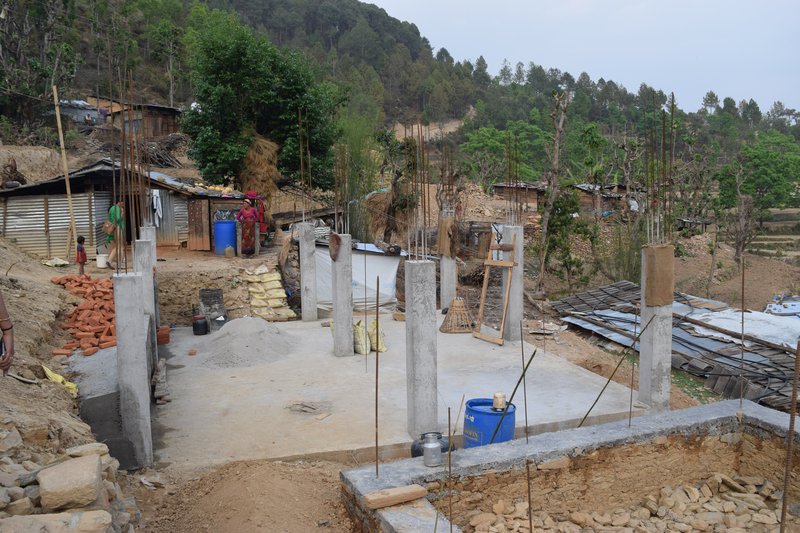
Although the earthquake affected one of the most poverty-stricken areas where people need money immediately to build earthquake resilient houses, the regulations have many technicalities and procedures and are so complicated that even the literate people find it difficult to interpret them all.
The act, regulation, procedures, and guidelines add conditions to conditions. They look like a bundle of distrust of the government on the victims who need to meet the conditions for grant assistance of Rs.300.000.
“If the government has a good intention towards the victims, it should have provided Rs. 300.000.00 in one installment or two installments. The government distrusts people so it lays condition after condition in the housing grant,” said Min Bahandur Shahi, coordinator of Humanitarian Accountability Monitoring Initiative, a consortium of rights-based NGOs. “If the process is difficult and complex, corruption and irregularities happen. We are concerned about the right of victims to move to a safe shelter as soon as possible,” said Shahi.
Helpless NRA
Although the National Reconstruction Authority (NRA) was established to pave the way for a quick reconstruction work from one window, the institution itself imposes guidelines after guidelines, involving many institutions.
NRA is working with a number of government ministries, including the Ministry of Federal Affairs and Local Development (MOFAL), Ministry Urban Development and others. MoFAL’s central level Program Implementation Unit and district Level Program Implementation Unit hold the primary responsibility for the disbursement of the housing grant.
The responsibility for technical standard and staffing for housing reconstruction are the responsibility of the Ministry of Urban Development through its CL-PIU and DL-PIU as well as Department of Urban Development and Building Construction.
Victims’ Woes
All these institutional arrangements finally hit the people. “I visited a number of offices and filled different paper works. My case is yet to be settled. I don’t know where I will get a respite,” said Bharati. “Had not the government announced the housing grant scheme, we would have constructed the home in some ways on our own.”
Kale Sarki, 55, a resident of Mundan-Deupur Municipality of Kavrepalanchwok district, has a different story to tell. He has already completed his house and moved to a new house almost six months ago. However, he is yet to receive the third tranche. “I have visited municipality and ward offices and engineers have visited my house twice but they declined to sign the completion paper showing technical lapses,” said Sarki.
“They visited my house twice during the construction period. They are now saying said that my house did not fulfill approved specification. I have followed approved building codes and guidelines during the construction, using iron, concrete, and cement. I hired masons trained by DDC. Despite all these, engineers decline to sign the completion paper.”
The delay in earthquake housing support does not last here. Seventy-three years-old, Bhanu Nepal, a resident of Tarkeshwor Municipality, Ward No 4, Kathmandu District, completed her house in August 2017 and has already shifted to her new house. Built with technical supervision and clearance from Municipality engineers, she is yet to get second and third installments. “We applied for second and third installments five months ago, with all documents and completion certificates issued by the Municipality. I don’t know when they will deposit money in my bank account.”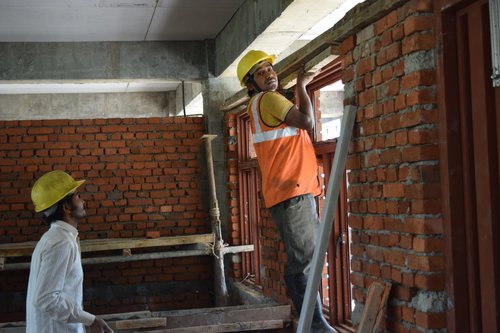
Out of 62 households of Dhobikhola, Ward 2 of Godavari Municipality, a majority of residents are yet to secure the private housing grant. “We have seen some of our neighbors, whose house was not damaged, already receiving the grant. There were cases of fraud and discrimination from the beginning. People who have political backing and access to power centers, got listed promptly and victims with no such backing were left behind,” said Purushottam Bishta. “The system of registration and testifying is itself wrong.”
Lengthy Process
There is the need to pass several steps to secure the grant. According to a provision of Housing Grant, all those eligible beneficiaries need to go to the office to sign the agreement. After signing the agreement ward office gives a copy to the beneficiary, another to Municipality and Rural Municipality and another copy to district level office Ministry of Federal and Local Development District Level Project Implementation Unit (DLPIU) with a recommendation of Ward office.
Beneficiaries need to carry citizenship certificate, photocopy of land ownership certificate and paper including a survey to sign the agreement in the ward office.
Following receiving the agreement, DLPIU verifies the name list, whether the name is matched or not. After finalization, DLPIU will send the document to District Coordinator Office of NRA before it reaches to District Treasury Controller Office (DTCO), which issues the cheque to deposit in the bank account of the beneficiary. After this, the beneficiary can go to the bank with the agreement paper to withdraw the money.
It will take at least two to three weeks to receive the money after finalization of the grant agreement. For the second installments, the beneficiary has to follow the same path except he needs certification from an engineer that he or she completed DPC. For the third tranche, there are several criteria, including the completion of a certificate from engineers.
“I spent three months to visit different offices to secure the first installment. I have already visited the municipal office twice to know about the state of second and third installments and bank officials have told me that they will inform me once the money is deposited, “said Nepal.
Other victims have similar complaints. “I have already filed applications in four different offices with ID, citizenship certificate and other documents to prove my claim,” said Bharati. “I have already spent more than thousand rupees to make the photocopy of documents and on bus travel.”
After receiving several complaints on the criteria of the private housing grant and guidelines as well as reconstruction modality, Nepal Reconstruction Authority (NRA) amended the guidelines and processes. But, the process is still lengthy and complex.
“I agree with that grants distribution takes long. There are several steps. Once the construction starts, the engineer deployed at the ward level goes for inspection to certify it. He then sends the file to district urban development and building construction office, where the file is scrutinized and then sent to district coordination committee. When the committee approves, the file is forwarded to the Financial General Comptroller Office, which secures entry of grants in bank accounts of the victims and forwards checks to the banks. Banks take time to complete the process again. This is why distribution is delayed,” CEO Yubaraj Bhusal told to media in a press conference.
“I tried to set a new provision whereby engineers at the ward level certify the process, an engineer at municipality or rural municipality approves it and then the respective local bodies recommend the Financial General Comptroller Office to release the money. Donors have not agreed to this provision. But then there are some victims who would not be able to build their houses even if you provide them millions in grants”
NRA officials justify the process arguing that this is required to prevent duplication, fraudulent cases and misuse of grant. “There are steps to fulfill as per the financial rules and regulations of the government. Some of them are mandatory requirements under the financial act,” said NRA spokesperson Yam Lal Bhoosal. “We cannot do anything so far as the process is concerned. If the documents do not back up, the Auditor’s General Office will declare the expenditure as ‘unaccounted for’, under the heading of Beruju.”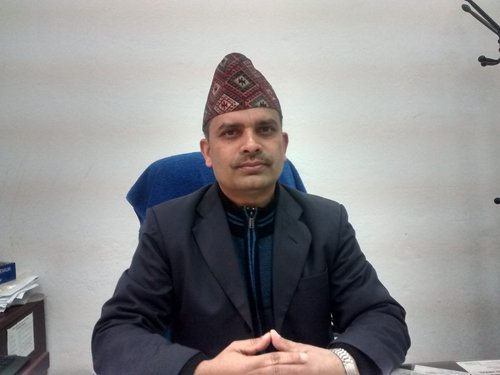
As many government institutions and paper works are involved before the cash reaching to the bank account, many victims may lose hopes.
Local Bodies
“There are many flaws. We are receiving a number of complaints regarding the process of distribution of grant. Since elected bodies are functioning now, the disbursement of earthquake reconstruction grant should be given to us. We will distribute the money effectively and efficiently to the concerned victims. At present, we are merely a recommendatory body. NRA deputes engineers and other technicians,” Gajendra Maharjan, mayor of Godavari Municipality, told New Spotlight. “When many paper works and technicalities are involved, unnatural delays happen. We know that there is the number of victims who are left out in the beneficiary list form Dhobikhola area and Municipality is taking the issue before higher officers.”
“Despite the local level elections, we are not given any decision making a role in finalizing the list of earthquake beneficiaries. However, we are blamed for the delay. Since local level started functioning, there is no need to have NRA anymore,” said Maharjan.
Maharjan’s anger is understandable as local bodies are given just a recommendatory role. Although the elected ward signed the agreement with beneficiaries, District Treasury Controller Office (DTCO) issues the cheque with a recommendation of DLPIU and NRA’s District Coordinator Unit.
Second and Third Tranches
The process of receiving second and third installment is technically lengthy as the beneficiary has to prove several paper works and technical inspections and approvals just to qualify. The case of Bhanu Nepal, a resident of Tarakeshwor Municipality of Kathmandu, just a few kilometers away from the capital, explains the efficiency of the system where one is unable to receive money even after the certification of the house by Municipality.
The experience of Kale Sarki of Mundan-Deupur Municipality shows uncertainty whether technically it will be approved or not. Although the correction and expectation manual has already been developed, there are many like Kale Sarki waiting for clearance for the third tranche.
“The process is tedious, lengthy and complex. We have been working in an extraordinary period in the humanitarian relief operation to build the houses for the victims. However, the process to acquire grant is more complicated than the normal process,” said Dr. Prabin Manandhar, country director of Lutheran World Federation and former chair of AIN. “Since the government is asking to build one story, three-room house, using a tin sheet, brick, cement, and soil, why does NRA need such complicated rules, regulations and technical design. Had victims been given Rs.300.000.00 in one go, most of the victims would have built their houses.”
With many bureaucratic hassles and technical issues, beneficiaries seem to have lost hopes. Out of 767705 beneficiaries, 670,086 received the first installment only, 15 percent applied for second and 38516 received third. Out of the total beneficiaries, 97619 or 13 percent is yet to secure the first installment.
“Although newly elected representatives have assured to provide us the money, victims have lost hope, given the prolonged delay,” said Purushotam Bishta, chairperson of Tindhara Watershed Drinking Water User Group.” With the grant money in our hand, we have already installed the drinking water supply before the stipulated time. I don’t know why the government does not trust us,” said Bishta.
Although the earthquake demolished his home completely, Bishta’s name was included recently in the beneficiary list. However, the grant is not allocated because of the issue of land ownership.
With the red card in his hand, he received all kind of reliefs in the early days, including the cash grants. However, he is disqualified now in the private housing grant because the land is not in his name.
Not only remote areas of Nepal, earthquake-affected poor and vulnerable communities living in the urban and peri-urban areas of Kathmandu, Lalitpur and Bhaktapur and many other people are facing difficulties to secure the government grant.
Deadline Missed
At a time when almost 70 percent of people are yet to apply for the second tranche and 100,000 thousand are yet to receive the first tranch, the deadline set by the National Reconstruction Authority (NRA) January 13, 2018 for the quake victims to receive the first installment of the grant to be eligible for the second installment of Rs 150,000 has already passed.
By the deadline, only 204,993 of the total 669,542 victims receiving the first tranche could manage to receive the second tranche.
If NRA does not amend the guidelines, those seventy percent victims, who missed the deadline, have now been deprived of the second tranche. Many were unable to manage to apply for the second tranche before the deadline due to lack of construction workers, construction materials and technical manpower to oversee reconstruction and get the recommendation for the second tranche.
Almost seventeen days have passed since the expiry of the deadline, the NRA has not been able to convene a meeting of the steering committee and decide the fate of the victims missing the deadline.
As executive committee of the NRA has no right to make any decision on what to do with the victims missing the deadline, there is uncertainty on the whole issue. According to NRA Act, only the prime minister-led steering committee has the authority to make the final decision.
“We are planning to propose a three-month extension of the deadline for the victims in the steering committee and resolve the problem soon,” said spokesperson Yam Lal Bhoosal.
Rights workers criticize NRA’s deadlines. “This is a gross violation of human rights. How can you set a deadline for the victims given the country’s situation?”
As the decision is yet to be made, many earthquake victims, who solely rely on the housing grant are likely to halt the reconstruction of their houses due to the lack of money.
“The executive committee will make a temporary arrangement until the steering committee's meeting is held,” said Spokesperson for NRA Bhoosal.
A per the deadline set by NRA in July 2017, all the victims will receive the grant for the reconstruction of private homes within the fiscal year 2017/018 ( which ends in mid-July 2018). According to the deadline, eligible beneficiaries must have signed a beneficiary agreement with local bodies by November 16, 2017, and the first tranche of the reconstruction grant must be secured by January 13, 2018, and third tranche by July 15, 2018.
Controversy on Identity
The process of identification of victims is in controversy from the very beginning. Before the formation of NRA, local bodies issued the ID with a recommendation from the all-party mechanism and field visit. There were complaints of duplicity and frauds in the registration of victims.
With political pressure and public complaints, NRA requested the Central Bureau of Statistics to survey victims in order to replace the first survey list, which was conducted on the basis of the house to house visits.
Under the first survey, local bodies issued three categories of cards to the victims depending upon the state of damage of the house. The red card was issued to those whose house was either destroyed completely or was unfit to live. The green card was for those whose property had not been damaged and yellow for partial damage.
“This is sheer negligence of the government institutions. There are rampant cases of unaccountability and misuse of authority at the local level in the selection and distribution of the grant. Employees are intentionally delaying the process. We have received reports of manipulation and favoritism during the process of selection of the victims. What I can say is that twenty percent of the beneficiaries entered the process through fraudulent methods, with close backing from political leadership. Many genuine victims are still left out,” said Padmini Pradhanaga, Vice president of Transparency International commenting in a recent discussion program in SAWTEE on reconstruction.
“This is a humanitarian assistance given at the time of crisis. We are suggesting shortening the procedure including the paperwork. If the beneficiaries are identified properly with valid documentation, the government should immediately release the fund. There were some incidents of irregularities in different places. During the CBS data collections, we received a number of complaints and incidents of irregularities. When there is so much of paperwork and procedures involved, nothing can be ruled out.”
Bharati and most of the residents of Dhobikhola of Godavari Municipality were identified in the list and received the red card. However, their names were removed from the second survey.
“From the very beginning, there is a fraudulent process of registration of earthquake victims. The name list is manipulated by the local level political leaders,” said Padmini Pradhanang, Vice President of Transparency International Nepal. “We have also received several complaints from genuine victims. There are complaints against government officials for irregularities and technicians for irresponsibility.”
Although the government issued earthquake victims family Identity Card to each family with details of damages suffered by them, there were complaints that local leaders in the affected VDCs were reported to engage in favoritism in the distribution of the ID cards. Some VDC secretaries complained that local leaders would register relatives, friends, and supporters even when they were not entitled to help.
The Commission for the Investigation of Abuse of Authority (CIAA) took actions against some VDC secretaries who were caught distributing ID cards to fake earthquake victims under the strong influence local party leaders and money. With so many controversies, CIAA directed the government to properly identify the victims.
With a view to collecting accurate data on the loss of lives and properties, with all vital details and uniformity, NRA ordered CBS to perform the survey.
Published by The Asia Foundation in April 2017, Independent Impacts and Recovery Monitoring Phase 4 reports that CBS damage survey report is more accurate to assess the damage and loss. Independent Impacts and Recovery Monitoring Phase 4 shows that the procedural amendment helped to accelerate the pace of reconstruction in all 31 districts and more people are receiving the first, second and third tranches compared to last year.
As it involved grant money, there is a rush of people to be included in the list. After the decision to conduct the second study, a number of people went to District Land Office to make two or three cards by splitting the family.
Construction Materials
At a time when reconstruction process is gradually picking up pace due to procedural corrections, the sudden hike in the prices of construction materials has forced people to abandon construction.
Unregulated increase in the prices has taken the locals back. "I had planned to build my house as per the standards of the government but I don't think I can afford it because of the rise in prices of the construction materials, “said Bishta.
As soon as the government published a notice warning the quake victims to take the second tranche of the grant within the second week of January, there had been a sharp increase in the prices of construction materials. In order to get the grant, victims somehow managed to build the foundation in a matter of days but they are not sure whether they will be able to build their house further.
Earlier, locals had to pay Rs 1200 to 1500 per tractor for gravels which have now jumped to Rs 2200 to 2500. Similarly, the price of iron and the galvanized sheet has increased, so is the labor cost.
With the direction of NRA, Department of Supply Management and Consumer Protection have asked cement factories to roll back the decision to increase the price of cement within three days.
“We have asked the cement manufacturers to roll back the prices. This is the case of the artificial price hike,” said Laxman Shrestha, director of the department. “We have issued a direction in the name of Nepal Cement Manufacturers' Association.” Price of other construction materials like a steel rod, sand and aggregate have also increased in recent weeks significantly.”
For the last thirty-three months, private housing reconstruction process has been passing through political interference, legal and procedural complexity and a market cartel. As the present pace and trend do not change, the suffering of the victims is likely to continue for a long time to come.
Purushottam Bishta, the chairperson of Dhobikhola Water User Group, is an earthquake victim who is yet to receive the grant. Bishta spoke to New Spotlight on various issues.
How do you see the state of earthquake victims?
After the earthquakes, many of us are yet to receive the grant assistance. However, we are able to rehabilitate the drinking water which was completely destroyed by the quake. So far as the grant is concerned, we are yet to receive the money even after signing the agreement. Names of many other victims are yet to be included in the list.
What changes have you seen in the area?
After the completion of rehabilitation work, people are getting the water. So far as the supply of drinking water is concerned, we are confident that there will be no problem with drinking water. This was possible because of coordination among NGOs, INGOs, local community and elected local bodies, including municipalities. They trusted the community and community proved that they can do it. Unlike housing grant, we did not face hassles of paperwork. They provided us construction materials and technical support; we built it through community contribution. There is a voluntary contribution of 736 days of labor work.
How many houses were reconstructed here?
There are fewer than ten houses reconstructed. First of all many victims are yet to receive the grant. Second is that the people do not have money as well. The alternative source is to sell the land. Either we have to sell the land or build on our own. Forget about second and third tranches, what do we expect from the government which has not released event the first tranche a year after signing the agreement. It seems that the process will go on for two decades.
This publication has been supported by The Asia Foundation. The contents of this publication reflect the views of the publication reflect the views of the author(s), researcher (s), and contributing editor (s) and do not necessarily reflect the views of The Asia Foundation.

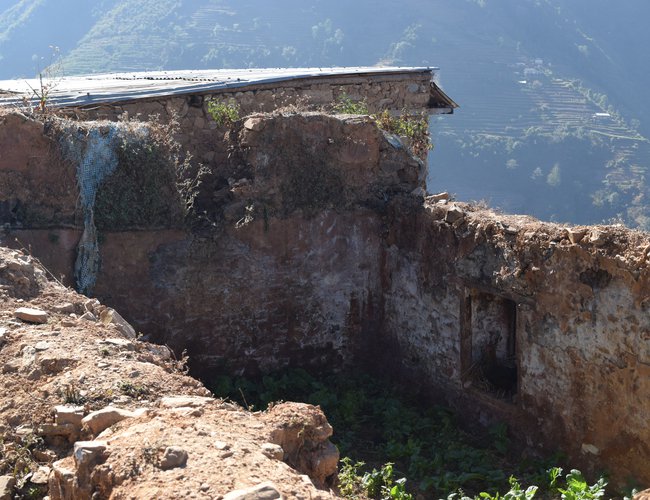
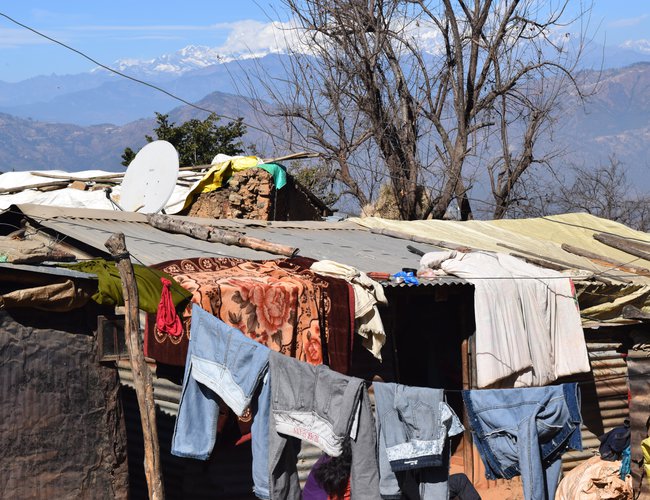

Keshab Poudel
Poudel is the editor of New Spotlight Magazine.
- FOURTH PROFESSOR Y.N. KHANAL LECTURE: Nepal-China Relations
- Jun 23, 2025
- Colonel JP CROSS: Centenary Birthday
- Jun 23, 2025
- REEEP-GREEN: Empowering Communities with MEP
- Jun 16, 2025
- BEEN: Retrofitted For Green
- May 28, 2025
- GGGI has been promoting green growth in Nepal for a decade: Dr. Malle Fofana
- May 21, 2025
